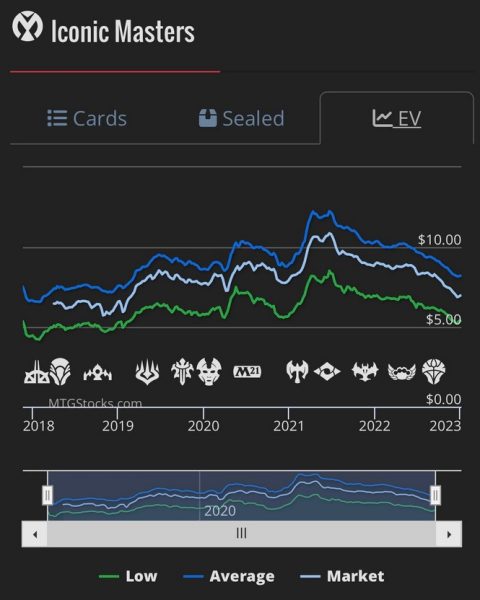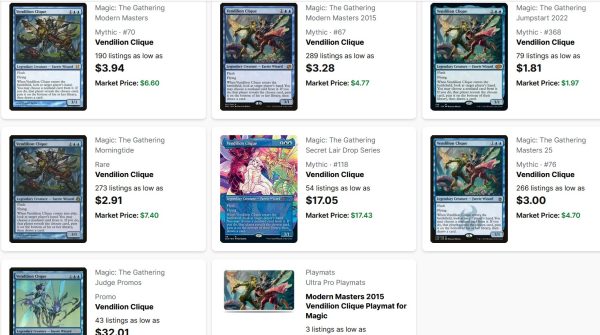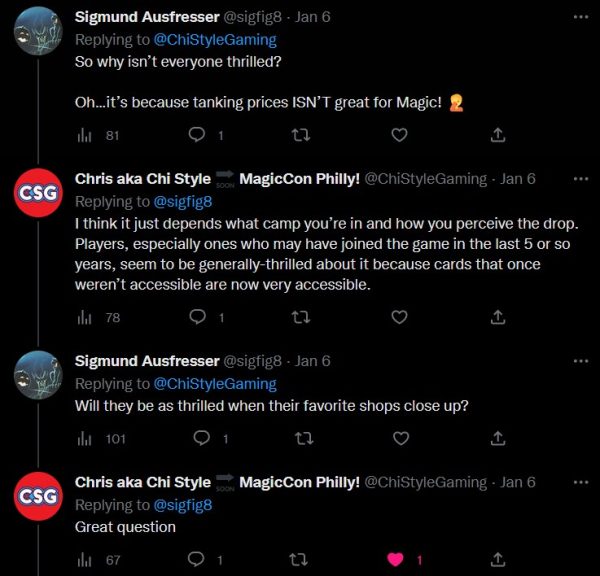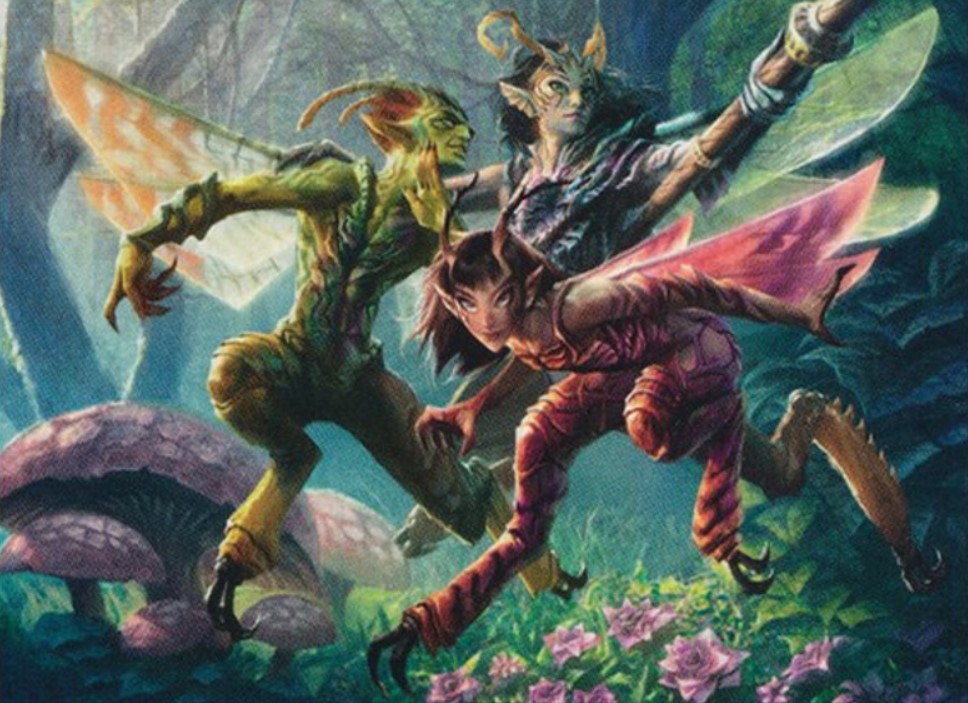Are you a Quiet Speculation member?
If not, now is a perfect time to join up! Our powerful tools, breaking-news analysis, and exclusive Discord channel will make sure you stay up to date and ahead of the curve.
Rewinding to a decade ago, I vividly remember a clamor from players and vendors alike for cheaper Magic singles. All these exciting, fun-to-play formats were getting “too expensive”.
Legacy had taken off, making Dual Lands and other format staples prohibitive to format entry. Modern was a huge hit after its launch in May 2011, but it was driving up prices of some important cards such as Shock Lands, Thoughtseize, and Tarmogoyf (despite a recent reprint in Modern Masters). Even Standard was contentiously costly, and players were unhappy with the format’s cost of entry because there were $50 cards (e.g. Bonfire of the Damned).
Acknowledging the outcry, Wizards responded. Reprints started pouring out in the form of Modern Masters, bringing much-needed supply to the market. Only the reprints did not consistently have the desired effect—in some cases, reprinted cards increased in price instead of decreasing!
Something had to be done! Magic was too expensive! Even vendors, whose livelihood depended on selling singles, were advocating reprints and price decreases. The overarching sentiment driving this desire: “I’d rather sell ten copies of a $10 card than 1 copy of a $100 card.”
“It’s Broken. Are You Happy Now?”
When I was growing up, my siblings and I had this strange novelty toy. Funnily enough, I don’t remember what it looked like, but I sure remember what it sounded like! The device would make sounds when activated, and those sounds were a selection of phrases an overbearing mother may say to her child after they misbehaved.
One of the phrases I distinctly remember was, “You’re going to poke somebody’s eye out with that thing!” This one inevitably got a laugh from family members seeing the device for the first time. The phrase that comes to mind when I think about Magic finance, however, is “It’s broken. Are you happy now?”
That is precisely what it feels like when I look at reprint volume and resulting pricing trends over the past year. Chris aka Chi Style (@ChiStyleGaming) created a thread on Twitter depicting set value trends using MTG Stocks data. The thread goes on and on, showcasing expected value (EV) charts from over two dozen sets. The trend in each one is the same (I chose Iconic Masters as an example):

It looks like card prices were on the rise throughout the pandemic, but as 2021 matured, that trend reversed. Then they continued, and prices are now below their pre-pandemic levels.
A single card that epitomizes this move for me is Vendilion Clique. I used to play this creature in a Commander deck many years ago. When I decided to budgetize my Commander decks, Vendilion Clique was cut—I couldn’t justify a $50 card in my deck simply because I didn’t play often enough.
Last week I saw someone tweet an article on Twitter that I had to retweet. It was a discourse by Michael Bahr, and he went on to explain some of what is happening in the collectible market regarding prices. He specifically called out Vendilion Clique as being reprinted so much that it’s now a $1 card. He wasn’t wrong—here’s the copy I ordered as part of a $5 purchase (so I could earn free shipping).

From over $50 to $1, if players wanted lower prices then they should be thrilled with this development. Are they, though? I’m not so sure—I see a lot of upset people on social media declaiming the lack of value of Magic cards. The magnitude of price decreases appears to be larger than people wanted. Now if you open a booster pack of the latest set, your odds of opening at least $4 back are longer than ever. Even if you open shiny foils and alternate art variants, you’re still looking at many bulk rares and mythic rares in a Standard-era set.
Valuable older cards are tumbling equally fast, not because of Standard but because of the proliferation of reprints upon reprints. It is endless, and it’s driving many perennial staples to all-time lows. Can this possibly be what everyone wanted?
In other words, “It’s broken. Are you happy now?”
Three Reasons This Isn’t a Good Thing
In reality, there are more than three reasons. This week, I want to touch on those that come to mind most readily.
Reason #1: Lack of Control
I suspect if we polled a group of TCGplayer vendors, they would still rather have higher liquidity and deal more in cards that have two-digit values than three- or four-digit values. I can certainly see how it’s easier to sell 50 $20 fetch lands than 1 $1000 Moat, for example.
Margins would also likely be better on a percentage basis, so as long as the volume remains sufficient, the proposition is attractive. The problem is, Wizards of the Coast has made it clear that they’re in charge when it comes to a) what gets reprinted, and b) how much a card gets reprinted.
Thanks to the Reserved List, we’ll never see Moat sell for $50 as many vendors appear to want. Instead, we’re seeing Vendilion Clique sell for $1. Another example is Tarmogoyf, which used to be over $100 and now can be purchased for $10. Is that what vendors wanted? Maybe that wouldn’t be so bad if demand increased in step, but I’m not so sure that’s the case.
How about Jace, the Mind Sculptor, which went from $150 to $30 thanks to all its reprints? Is that the right price point for vendors to be happy?
To be fair, Big Jace, Vendilion Clique, and Tarmogoyf were once Modern and/or Legacy powerhouses. You couldn't go to a large event without seeing these cards show up time and again. Thanks to continuous power creep in the game, however, these have seen a diminishing demand. The combination of reprints plus power creep making these cards obsolete has really punished their prices the most. It's no wonder Clique, once a $50 card, can now be found in the dollar bin!
Older cards aren't immune either. Remember when Mana Drain was an amazing pull worth $150 from a booster pack of Iconic Masters? Now it’s $30. Don’t even get me started on Sol Ring, which is becoming virtual bulk because of its infinite reprints. There are more expensive copies to be found, sure, but this is about finding the cheapest copies of a card for play purposes.
Then there's Rishadan Port, Imperial Recruiter, Temporal Manipulation... the list goes on and on. My point here isn’t that one price reduction is better than another. My point is just that we have no control over what drops and by how much. Only Wizards of the Coast has the keys to that car, and I’m not sure they’re licensed to drive. This lack of control makes the prospect of reprint-driven price reductions a dicey proposition in my mind, and one I would not opt into given the choice.
Reason #2: Margin Erosion
I stated above my hypothesis that margins improve on a $20 card relative to a $1000 card—a vendor may pay $12 for the former and $750 on the latter, meaning the percentage profit is greater on the cheaper card. There is a point of diminishing returns in this calculation, however, as average prices (and therefore, average baskets) drop further and further.
Consider the Vendilion Clique purchase I made recently—here’s the snapshot of the full order:

What do you think the profit margin was for this vendor? I earned free shipping, so the vendor had to spend their time picking out these cards and packaging them, and then $0.50 on a stamp just to ship them to me. Then TCGplayer took their cut. When the dust settles, they’d be lucky to net $3 from this sale.
Was this worth their while? I suppose it's because prices were so low that I made this purchase—had Vendilion Clique still been $50 and Gravecrawler $10, I wouldn’t have made this purchase. It’s true, this seller is likely seeing more volume thanks to reprints.
At what cost, though? I’d argue it’s at the cost of margins, and I’m just not sure if all the proliferated vendors out there can survive a world where this is the average shopping basket they have to fulfill. Cards going from $100 to $30 may be fine, but cards going from $50 to $1 likely aren’t. Where’s the line?
Reason #3: SKU Proliferation
Another downside to dropping prices is how the price reductions are achieved: through massive reprints. Not just Standard reprints, mind you. That could be a more direct, less complicated way of achieving the goal. Unfortunately, you just can’t put every card that needs a reprint into Standard.
Instead, we’re getting set after set of reprints—I can’t even keep track of them all! There are Commander sets, Secret Lairs, Masters sets, The List, Promos, and the list goes on. What does this mean for vendors? It means they have to physically keep track of every single variation that’s printed!
No longer is there just one or two versions of Vendilion Clique. Now there are seven, not counting foil versions from each set. Including those brings the total number up to over a dozen!

That’s not even an extreme example! Certain reprints include alternative arts and alternative foil treatments. Don’t even get me started on Sol Ring.
I can’t imagine all this SKU proliferation is easy for vendors to deal with. The problem is only getting worse with every single set release.
Wrapping It Up
I barely scratched the surface of some of the issues I see with the new world of cheaper card prices. For example, I didn’t even paint the external context surrounding this macro-trend in Magic. Namely, the current economic weakness we’re seeing and the spike in inflation. Not only are card prices decreasing in absolute, but also their values are decreasing because the purchasing power of the U.S. dollar is falling.
Factoring in inflation from the past year, a $100 card that dropped to $30 is really only “worth” $25 (numbers are arbitrary to illustrate the trend). In the meantime, high inflation means vendor overhead costs are rising, including rent, utilities, employee pay, etc.
This is precisely why I responded to Chris the way I did on Twitter. It seems he is in agreement.

In the case of declining prices, there is definitely too much of a good thing. I’m thrilled that I can once again play Vendilion Clique cheaply in Commander, but at what cost? Would I rather vendors feel tremendous economic pressure, causing many LGSs across the country to fold so that I can have a $1 Vendilion Clique? Certainly not.
It’s definitely possible to overdo price declines, and I for one say it’s time for Wizards to halt with reprints and let the market stabilize, even if it means price increases in the short term. The reprieve would be healthy for the game, and I think even some vendors may come to appreciate that move in the long run.





Great article, but your wrap up statement is predicated on the idea that WOTC cares about vendors. They have shown that they do not by simply becoming the retailer themselves, and slowly killing the secondary market. Now, on a side note, they are trying to do the same thing to their other brand, D&D. Sadly, these moves by WOTC over the last few years were predictable. While there may be room for the creativity of MTG to grow, it would never meets the lofty expectations of a company that is shareholder focused, versus consumer focused. I highly doubt those two groups overlap. WOTC knew they were nearing an endgame of sorts, and their Hail Mary was just that, flood the market with enough versions of cheaply produced product so that one of them “might” be for you. This change meant deciding to focus on draft versus collecting, and then to simply, not buying their product at all. The card quality, marketing hubris, and lack of support for my friends who own local game stores meant the end for me. I think the glory days of this game are over for the time being.
Another big mistake was removing the Legacy format entirely from paper events when Pioneer was introduced. Many players who had paid a lot of hard earned money for the past few years saw the value of their cards plummet almost overnight. That Legacy has been brought back as one of the main formats is only thanks to the Magic Arena. Now with all the reprints it doesn’t seem like those prices will ever recover. A foil Tarmogoyf still holds great value but only for the collector’s market.